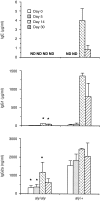Impaired protective immunity and T helper 2 responses in alymphoplasia (aly) mutant mice infected with Trichinella spiralis
- PMID: 11260327
- PMCID: PMC1783161
- DOI: 10.1046/j.1365-2567.2001.01169.x
Impaired protective immunity and T helper 2 responses in alymphoplasia (aly) mutant mice infected with Trichinella spiralis
Abstract
The alymphoplasia (aly) mutation of mice prevents the development of systemic lymph nodes and Peyer's patches. The mutant homozygotes (aly/aly) are partially deficient in both humoral and cell-mediated immune functions. In the present study, we show that adult worm expulsion was slightly delayed and that T helper 2 (Th2)-type responses were partially defective in aly/aly mice after infection with Trichinella spiralis. Male aly/aly and aly/+ mice (8-weeks old) were infected with 400 muscle larvae. There was no difference in worm recovery between the two groups on day 5. However, worm recovery in aly/aly mice was significantly higher than that in aly/+ mice on day 14. Mucosal mast cells increased in number and peaked 14 days after infection in aly/+ mice. aly/aly mice were deficient in their mucosal mast cell response through out the primary infection. To examine the existence of mast cell precursors, aly/aly mice were treated with recombinant interleukin-3 (rIL-3) before infection. The mast cell response was poorly induced in aly/aly mice treated with rIL-3. An immunoglobulin E (IgE) response was not detected in aly/aly mice during the course of infection. Serum IgG1 levels in aly/aly mice were significantly lower than that of aly/+. The serum IgG2a levels increased in both strains of mice. However, IgG2a production in aly/aly mice on day 14 was half as much as that in aly/+mice. Stimulation of splenic T cells in vitro with anti-CD3 monoclonal antibody (mAb) showed that spleen cells from aly/+ mice on day 5 produced more IL-4 than spleen cells from aly/aly mice. IL-4 production from aly/aly mice on day 14 was half that from aly/+ mice. Interferon-gamma (IFN-gamma) was produced in both aly/aly and aly/+ mice on day 14. Proliferation assay showed that T cells of aly/aly mice responded poorly when cultured with antigen-presenting cells. These results suggest that aly gene is needed for the induction of protective immunity and Th2 responses in mice infected with T. spiralis.
Figures





Similar articles
-
IL-18 regulates intestinal mastocytosis and Th2 cytokine production independently of IFN-gamma during Trichinella spiralis infection.J Immunol. 2002 Sep 1;169(5):2553-60. doi: 10.4049/jimmunol.169.5.2553. J Immunol. 2002. PMID: 12193725
-
Immunity to Trichinella spiralis infection in vitamin A-deficient mice.J Exp Med. 1992 Jan 1;175(1):111-20. doi: 10.1084/jem.175.1.111. J Exp Med. 1992. PMID: 1730911 Free PMC article.
-
Injection of recombinant interleukin 3 hastens worm expulsion in mice infected with Trichinella spiralis.Parasitol Res. 1996;82(2):108-13. doi: 10.1007/s004360050079. Parasitol Res. 1996. PMID: 8825203
-
Exogenous interleukin-3 enhances IL-4 production by splenic CD4+ cells during the early stages of a Trichinella spiralis infection.Int Arch Allergy Immunol. 1998 Oct;117(2):131-7. doi: 10.1159/000024000. Int Arch Allergy Immunol. 1998. PMID: 9784657
-
Stat6 signaling promotes protective immunity against Trichinella spiralis through a mast cell- and T cell-dependent mechanism.J Immunol. 2000 Feb 15;164(4):2046-52. doi: 10.4049/jimmunol.164.4.2046. J Immunol. 2000. PMID: 10657657
Cited by
-
NF-(kappa)B-inducing kinase controls lymphocyte and osteoclast activities in inflammatory arthritis.J Clin Invest. 2005 Jul;115(7):1848-54. doi: 10.1172/JCI23763. Epub 2005 Jun 2. J Clin Invest. 2005. PMID: 15937549 Free PMC article.
-
Th17 cells influence intestinal muscle contraction during Trichinella spiralis infection.J Huazhong Univ Sci Technolog Med Sci. 2009 Aug;29(4):481-5. doi: 10.1007/s11596-009-0418-4. Epub 2009 Aug 7. J Huazhong Univ Sci Technolog Med Sci. 2009. PMID: 19662367
-
NIK prevents the development of hypereosinophilic syndrome-like disease in mice independent of IKKα activation.J Immunol. 2012 May 1;188(9):4602-10. doi: 10.4049/jimmunol.1200021. Epub 2012 Apr 2. J Immunol. 2012. PMID: 22474019 Free PMC article.
-
The nonsense-mediated RNA decay pathway is disrupted in inflammatory myofibroblastic tumors.J Clin Invest. 2016 Aug 1;126(8):3058-62. doi: 10.1172/JCI86508. Epub 2016 Jun 27. J Clin Invest. 2016. PMID: 27348585 Free PMC article.
References
-
- Mayer L, Blumberg RS. Antigen-presenting cells: Epithelial cells. In: Ogra PL, Mestecky J, Lamm ME, Strober W, Bienenstock J, McGhee JR, editors. Mucosal Immunology. 2. San Diego: Academic Press; 1999. pp. 365–79.
-
- Miyawaki S, Nakamura Y, Suzuka H, Koba M, Yasuzumi R, Ikehara S, Shibata Y. A new mutation, aly, that induces a generalized lack of lymph nodes accompanied by immunodeficiency in mice. Eur J Immunol. 1994;24:429–34. - PubMed
-
- Shinkura R, Kitada K, Matsuda F, et al. Alympholasia is caused by a point mutation in the mouse gene encoding NF-κB-inducing kinase. Nat Genet. 1999;22:74–7. 10.1038/8780. - DOI - PubMed
-
- Wang CH, Korenaga M, Sacuto FR, Ahmad A, Bell R. Intraintestinal migration to the epithelium of protective, dividing, anti-Trichinella spiralis CD4+ OX22– cells requires MHC class II compatibility. J Immunol. 1990;145:1021–8. - PubMed
Publication types
MeSH terms
Substances
LinkOut - more resources
Full Text Sources
Molecular Biology Databases

